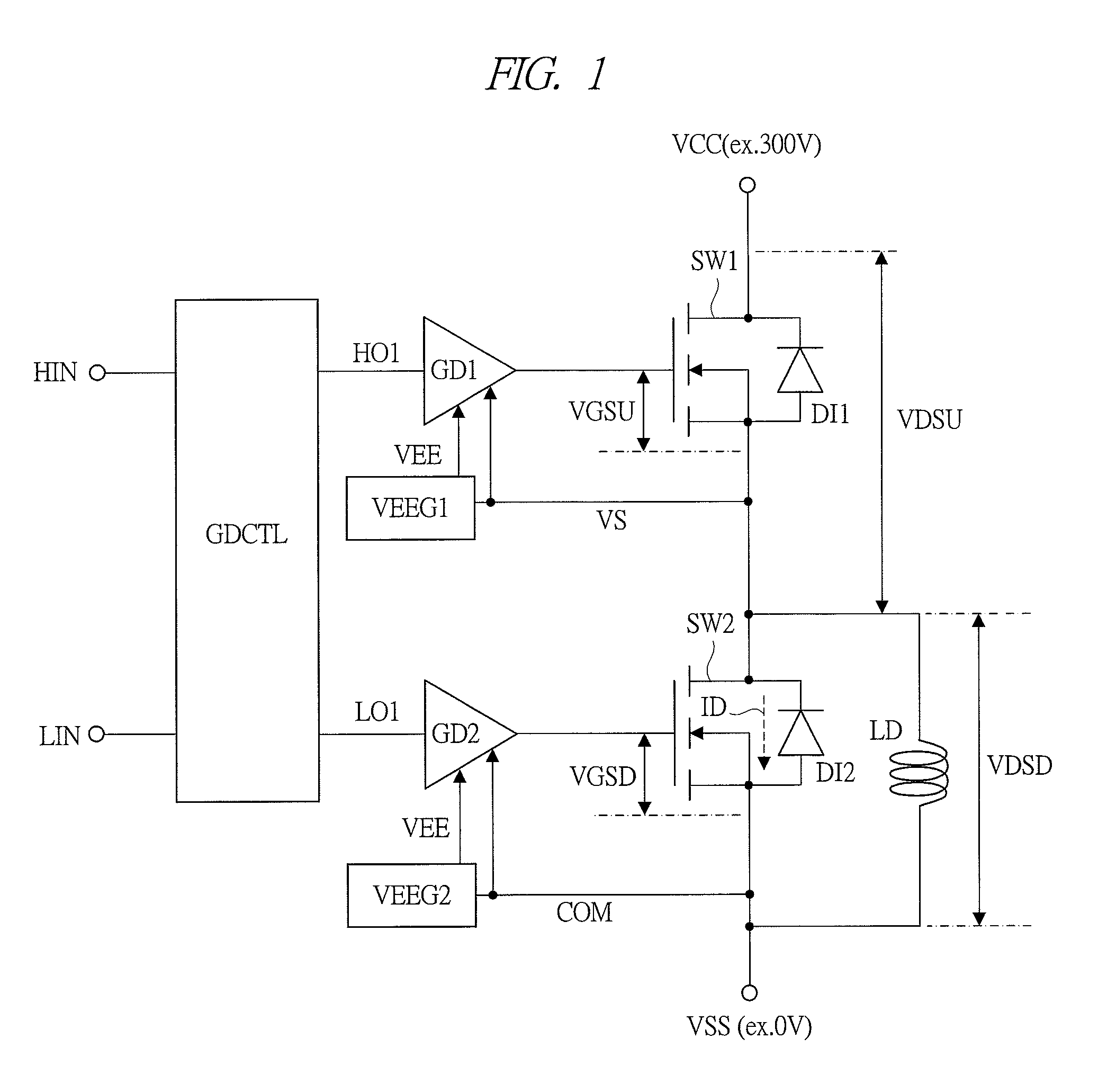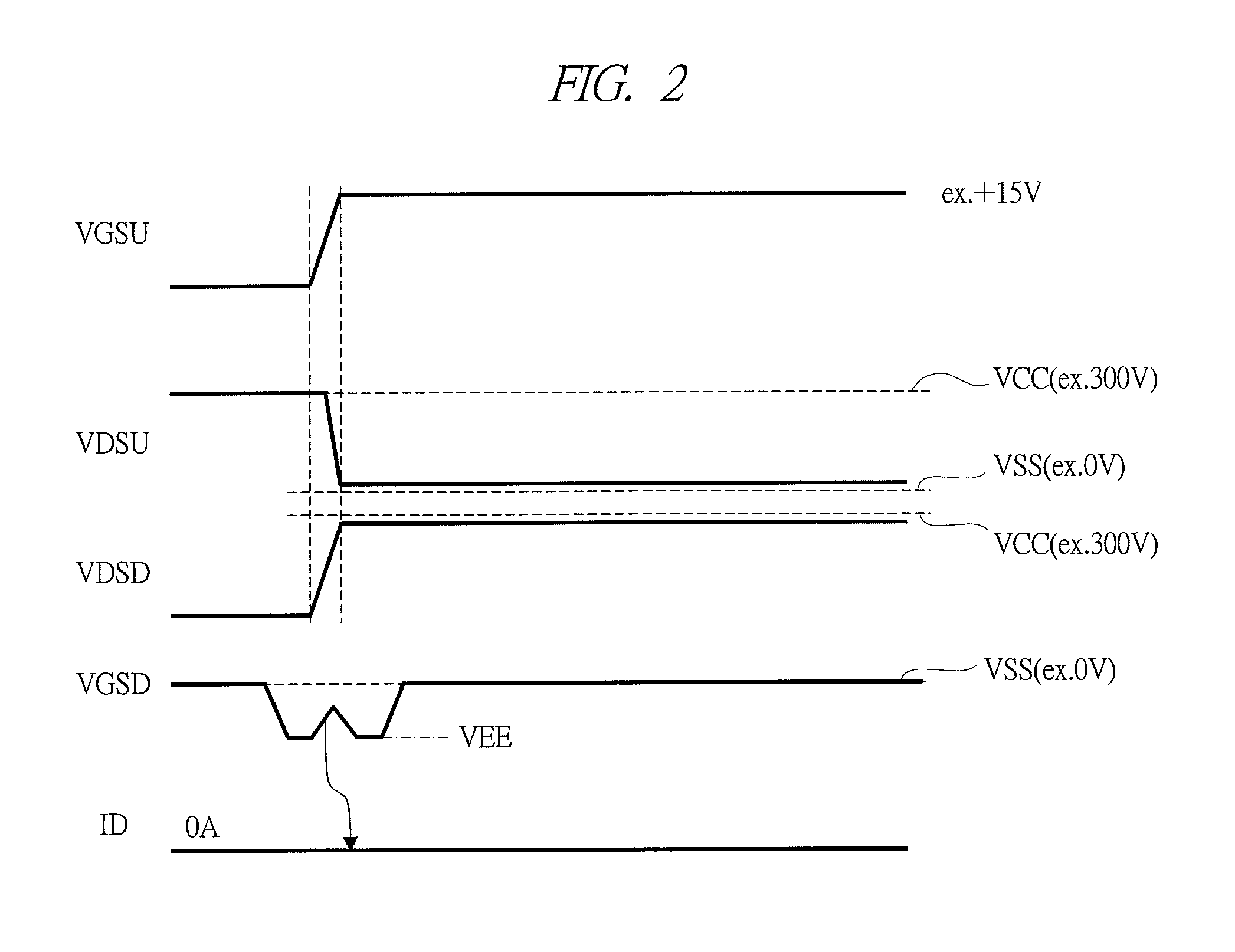Semiconductor driver circuit and power conversion device
a technology of driver circuit and power conversion device, which is applied in the direction of pulse generator, pulse technique, instruments, etc., to achieve the effects of improving power device performance, improving infrastructural power efficiency, and reducing environmental burden
- Summary
- Abstract
- Description
- Claims
- Application Information
AI Technical Summary
Benefits of technology
Problems solved by technology
Method used
Image
Examples
first embodiment
[0038](First Embodiment)
[0039]>
[0040]FIG. 1 is a schematic diagram illustrating a configuration example of a principal part of a power conversion device according to a first embodiment of the present invention. Here, the power conversion device as illustrated in FIG. 1 is a half bridge circuit. The half bridge circuit is appropriately used for such various purposes as a part of a power supply device of a DC / DC conversion circuit or others, as a part of a power supply device of a DC / AC conversion circuit or others by expansion into a full bridge circuit, a three phase inverter circuit, or others, and as a part of a motor control device. The half bridge circuit of FIG. 1 is provided with: a gate driver control circuit GDCTL; an upper-arm side switch element SW1 and a lower-arm side switch element SW2; free wheel diodes DI1 and DI2 corresponding to the respective switch elements SW1 and SW2; gate driver circuits GD1 and GD2 corresponding thereto; and negative-potential generating circu...
second embodiment
[0070](Second Embodiment)
[0071]>
[0072]FIG. 7 is a schematic diagram illustrating a configuration example of a principal part of a power conversion device according to a second embodiment of the present invention. The power conversion device as illustrated in FIG. 7 has a configuration with additional current detecting resistors Rs1 and Rs2 and current detecting circuits ISEN1 and ISEN2 in comparison to the configuration example of FIG. 1. The Rs1 is inserted between the source of the upper-arm side switch element SW1 and the drain of the lower-arm side switch element SW2, and the Rs2 is inserted between the source of the SW2 and the ground power supply voltage VSS. The ISEN1 detects a voltage between both ends of the Rs1 and outputs a detected voltage signal CM1, and the ISEN2 detects a voltage between both ends of the Rs2 and outputs a detected voltage signal CM2. The CM1 and CM2 are used in the negative potential generating circuit VEEG1 and VEEG2, respectively.
[0073]FIG. 8 is a s...
third embodiment
[0075](Third Embodiment)
[0076]>
[0077]FIG. 9 is a schematic diagram illustrating one example of a configuration of a power conversion device according to a third embodiment of the present invention. The power conversion device illustrated in FIG. 9 is obtained by, for example, applying the method of the first embodiment to so-called three-phase inverter device. In FIG. 9, each of SW1u, SW1v, SW1w, SW2u, SW2v, and SW2w is a switch element using an n-channel type SiCMOS, and respective free wheel diodes D1u, D1v, D1w, D2u, D2v, D2w are connected to between the respective sources and drains. The SW1u, SW1v, and SW1w are arranged on the upper-arm side while the SW2u, SW2v, and SW2w are arranged on the lower-arm side, and the SW1u and SW2u are for a U phase, the SW1v and SW2v are for a V phase, and the SW1w and SW2w are for a W phase.
[0078]GD1u, GD1v, GD1w, GD2u, GD2v, and GD2w are gate driver circuits as illustrated in FIG. 1, and drive the SW1u, SW1v, SW1w, SW2u, SW2v, and SW2w, respect...
PUM
 Login to View More
Login to View More Abstract
Description
Claims
Application Information
 Login to View More
Login to View More - R&D
- Intellectual Property
- Life Sciences
- Materials
- Tech Scout
- Unparalleled Data Quality
- Higher Quality Content
- 60% Fewer Hallucinations
Browse by: Latest US Patents, China's latest patents, Technical Efficacy Thesaurus, Application Domain, Technology Topic, Popular Technical Reports.
© 2025 PatSnap. All rights reserved.Legal|Privacy policy|Modern Slavery Act Transparency Statement|Sitemap|About US| Contact US: help@patsnap.com



